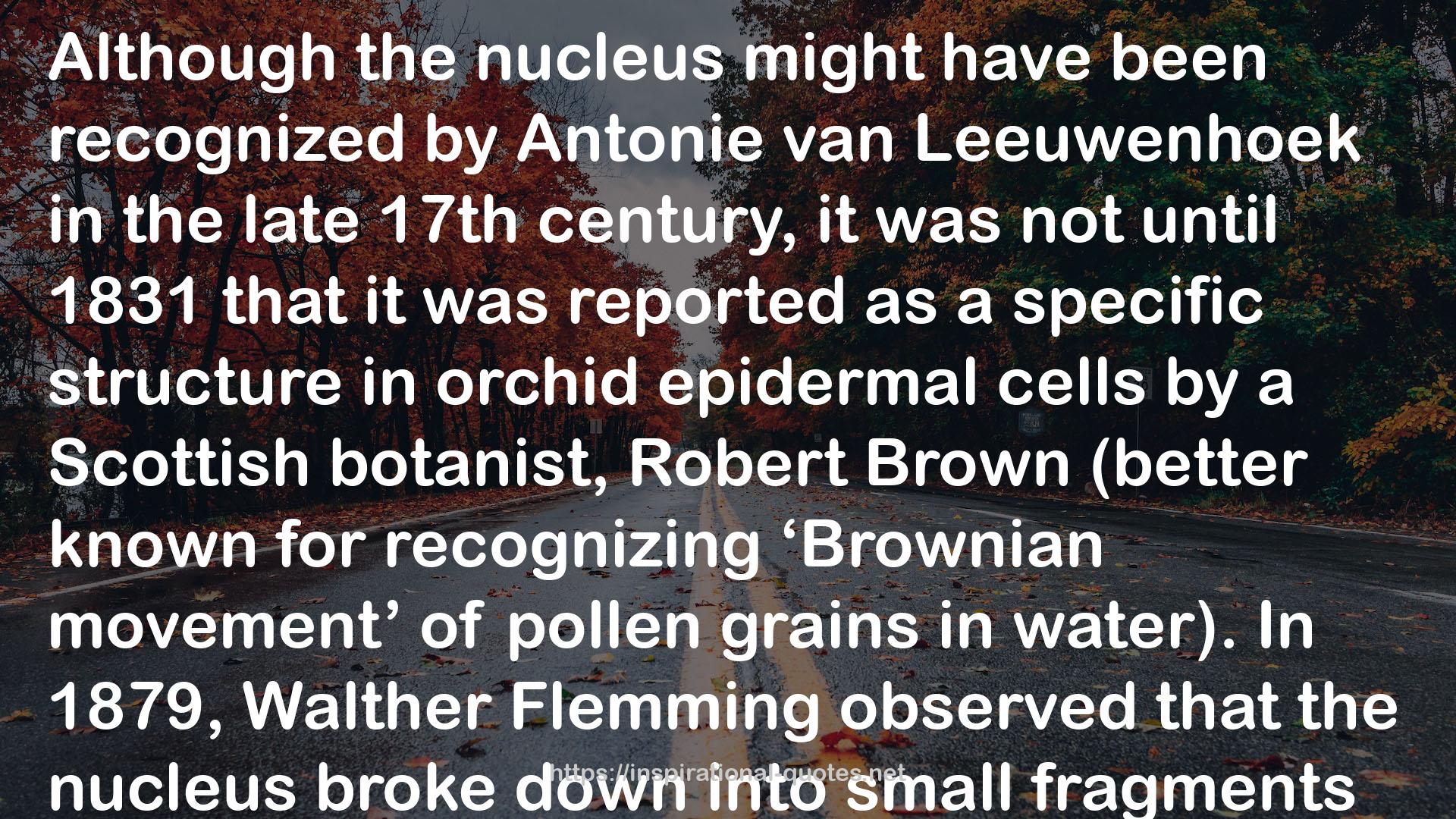" Although the nucleus might have been recognized by Antonie van Leeuwenhoek in the late 17th century, it was not until 1831 that it was reported as a specific structure in orchid epidermal cells by a Scottish botanist, Robert Brown (better known for recognizing ‘Brownian movement’ of pollen grains in water). In 1879, Walther Flemming observed that the nucleus broke down into small fragments at cell division, followed by re-formation of the fragments called chromosomes to make new nuclei in the daughter cells. It was not until 1902 that Walter Sutton and Theodor Boveri independently linked chromosomes directly to mammalian inheritance. Thomas Morgan’s work with fruit flies (Drosophila) at the start of the 20th century showed specific characters positioned along the length of the chromosomes, followed by the realization by Oswald Avery in 1944 that the genetic material was DNA. Some nine years later, James Watson and Francis Crick showed the structure of DNA to be a double helix, for which they shared the Nobel Prize in 1962 with Maurice Wilkins, whose laboratory had provided the evidence that led to the discovery. Rosalind Franklin, whose X-ray diffraction images of DNA from the Wilkins lab had been the key to DNA structure, died of cancer aged 37 in 1958, and Nobel Prizes are not awarded posthumously. Watson and Crick published the classic double helix model in 1953. The final piece in the jigsaw of DNA structure was produced by Watson with the realization that the pairing of the nucleotide bases, adenine with thymine and guanine with cytosine, not only provided the rungs holding the twisting ladder of DNA together, but also provided a code for accurate replication and a template for protein assembly. Crick continued to study and elucidate the base pairing required for coding proteins, and this led to the fundamental ‘dogma’ that ‘DNA makes RNA and RNA makes protein’. The discovery of DNA structure marked an enormous advance in biology, probably the most significant since Darwin’s publication of
On the Origin of Species
. "
― , The Cell: A Very Short Introduction
Image for Quotes

James Watson and
Francis Crick showed the structure of DNA to be a double helix, for which they shared the Nobel Prize in 1962 with
Maurice Wilkins, whose laboratory had provided the evidence that led to the discovery. Rosalind Franklin, whose X-ray diffraction images of DNA from the Wilkins lab had been the key to DNA structure, died of cancer aged 37 in 1958, and Nobel Prizes are not awarded posthumously. Watson and Crick published the classic double helix model in 1953. The final piece in the jigsaw of DNA structure was produced by Watson with the realization that the pairing of the nucleotide bases, adenine with thymine and guanine with cytosine, not only provided the rungs holding the twisting ladder of DNA together, but also provided a code for accurate replication and a template for protein assembly. Crick continued to study and elucidate the base pairing required for coding proteins, and this led to the fundamental ‘dogma’ that ‘DNA makes RNA and RNA makes protein’. The discovery of DNA structure marked an enormous advance in biology, probably the most significant since Darwin’s publication of
On the Origin of Species
." style="width:100%;margin:20px 0;"/>
 James Watson and Francis Crick showed the structure of DNA to be a double helix, for which they shared the Nobel Prize in 1962 with Maurice Wilkins, whose laboratory had provided the evidence that led to the discovery. Rosalind Franklin, whose X-ray diffraction images of DNA from the Wilkins lab had been the key to DNA structure, died of cancer aged 37 in 1958, and Nobel Prizes are not awarded posthumously. Watson and Crick published the classic double helix model in 1953. The final piece in the jigsaw of DNA structure was produced by Watson with the realization that the pairing of the nucleotide bases, adenine with thymine and guanine with cytosine, not only provided the rungs holding the twisting ladder of DNA together, but also provided a code for accurate replication and a template for protein assembly. Crick continued to study and elucidate the base pairing required for coding proteins, and this led to the fundamental ‘dogma’ that ‘DNA makes RNA and RNA makes protein’. The discovery of DNA structure marked an enormous advance in biology, probably the most significant since Darwin’s publication of
On the Origin of Species
." style="width:100%;margin:20px 0;"/>
James Watson and Francis Crick showed the structure of DNA to be a double helix, for which they shared the Nobel Prize in 1962 with Maurice Wilkins, whose laboratory had provided the evidence that led to the discovery. Rosalind Franklin, whose X-ray diffraction images of DNA from the Wilkins lab had been the key to DNA structure, died of cancer aged 37 in 1958, and Nobel Prizes are not awarded posthumously. Watson and Crick published the classic double helix model in 1953. The final piece in the jigsaw of DNA structure was produced by Watson with the realization that the pairing of the nucleotide bases, adenine with thymine and guanine with cytosine, not only provided the rungs holding the twisting ladder of DNA together, but also provided a code for accurate replication and a template for protein assembly. Crick continued to study and elucidate the base pairing required for coding proteins, and this led to the fundamental ‘dogma’ that ‘DNA makes RNA and RNA makes protein’. The discovery of DNA structure marked an enormous advance in biology, probably the most significant since Darwin’s publication of
On the Origin of Species
." style="width:100%;margin:20px 0;"/>